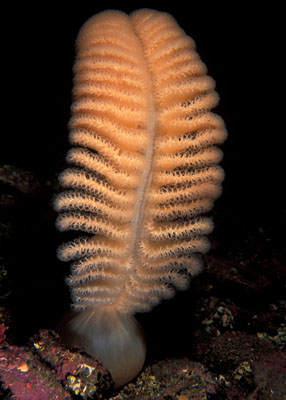Today I decided to look at an organism called
Thaumaptilon (wonderful soft-feather)
as it is believed to be a survivor from the Ediacaran fauna which was found in the Burgess Shale of the mid-Cambrian. This superficially leaf-like animal is considered to be a cnidarian and lived its life attached to the sea floor by a holdfast. It grew to around 8 inches and was covered in spots on one side which may have been zooids, suggesting it was a colonial animal.
These animals were once thought to be sea pens, like the one in the image on the right, however, this has been strongly questioned on numerous lines of evidence. So why have I chosen something which is similar to a sea pen and didn't really do much? Well,
Thaumaptilon was linked to Ediacaran forms such as
Charnia which had long been tricky to classify (it still is). If
Thaumaptilon was indeed both related to
Charnia and to modern pennatulacean cnidarians (sea-pens) then it would be strong case against the concept of the Vendobionta of Adolf Seilacher. Seilacher proposed that the Ediacaran organisms were an evolutionary experiment in multicellularity which left no descendants. He also proposed that these quilted forms, of which
Charnia was one, had a hard outer layer which explained why they fossilised so well. Modern sea-pens do not have this outer layer and so the link would have dealt a heavy blow against it.
This image shows
Thaumaptilon along with the Ediacaran forms
Charnia and
Spriggina. Charnia is named after Charnwood Forest in Leicestershire where it was initially discovered (so I have managed to keep most of the critters British so far).
Spriggina is quite fascinating as it has been classified as an annelid worm, a rangeomorph frond, an arthropod (possible trilobite ancestor), and a proarticulate. In this image is another Cambrian form,
Stromatoveris, which has been classified as a ctenophore. The image below shows a potential phylogeny on which both
Thaumaptilon and
Stromatoveris can be seen.
I wouldn't like to comment on the potential relationship with
Charnia at the moment. Current popular opinion seems to be that we just don't know. The Ediacaran and early Cambrian fauna are some of the most difficult to study enigmatic organisms known to palaeontology.
Thaumaptilon may not have been doing much when it was alive, but from a palaeontological perspective it is fascinating.





No comments:
Post a Comment